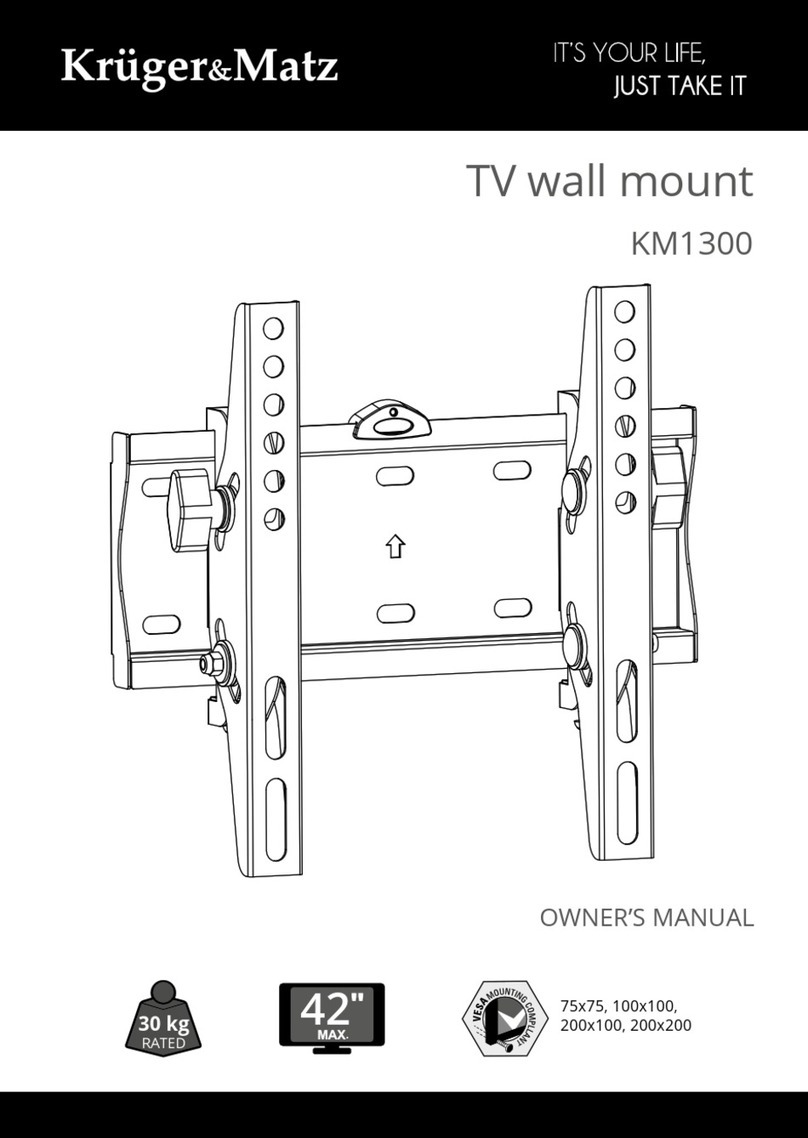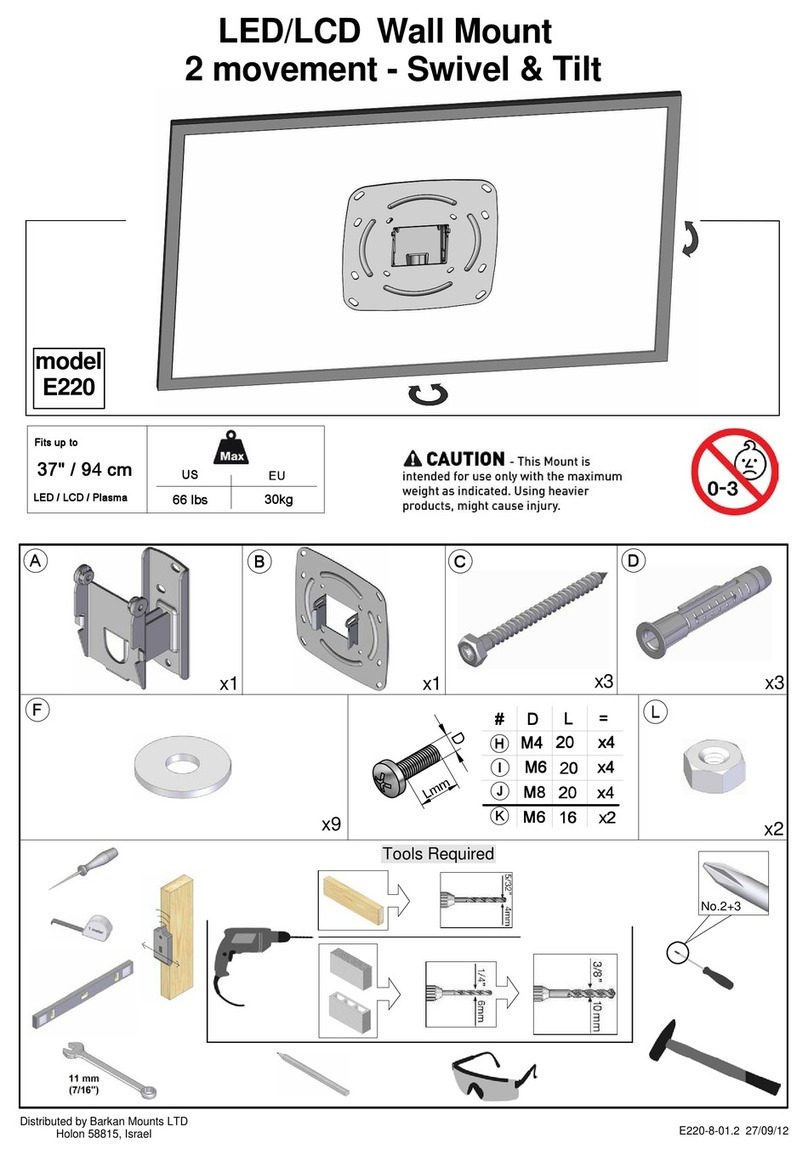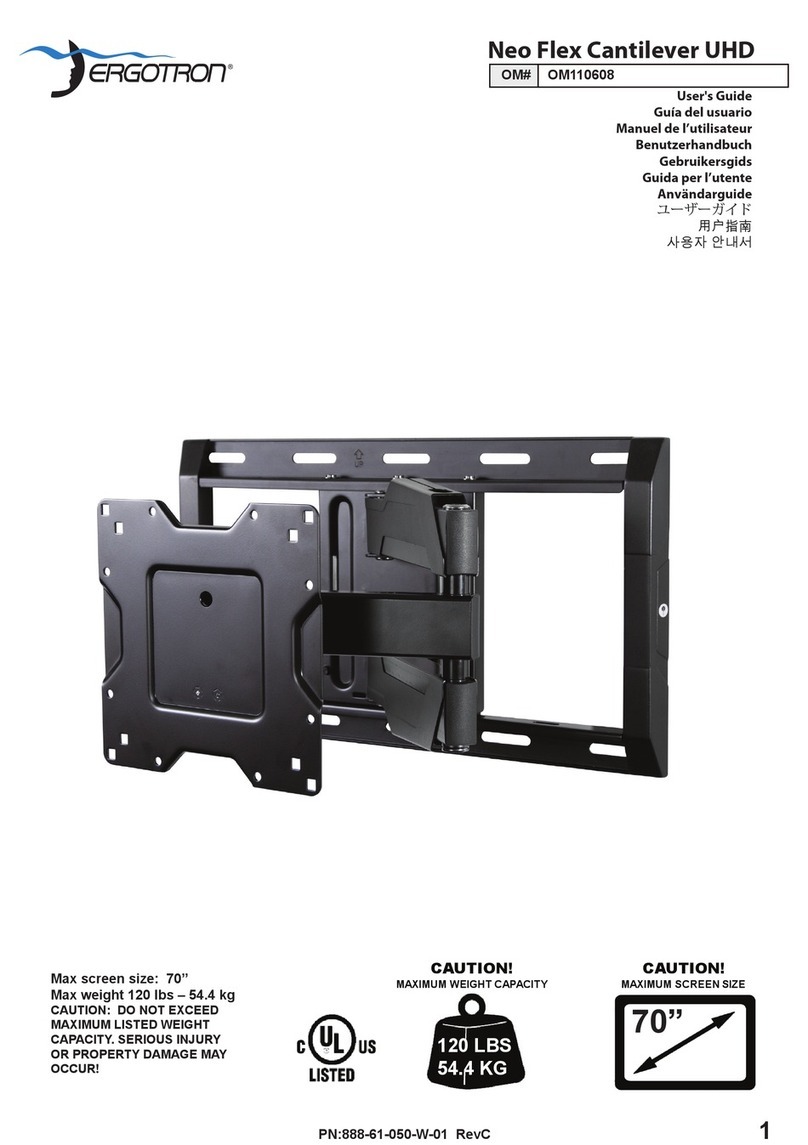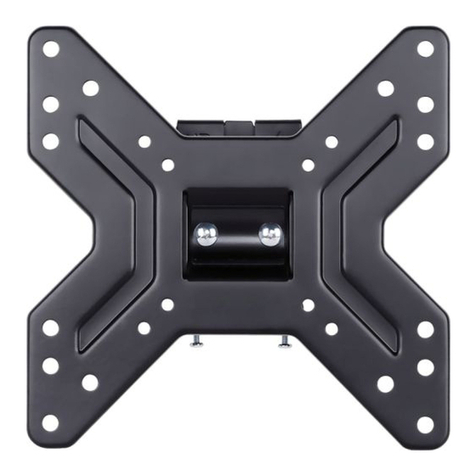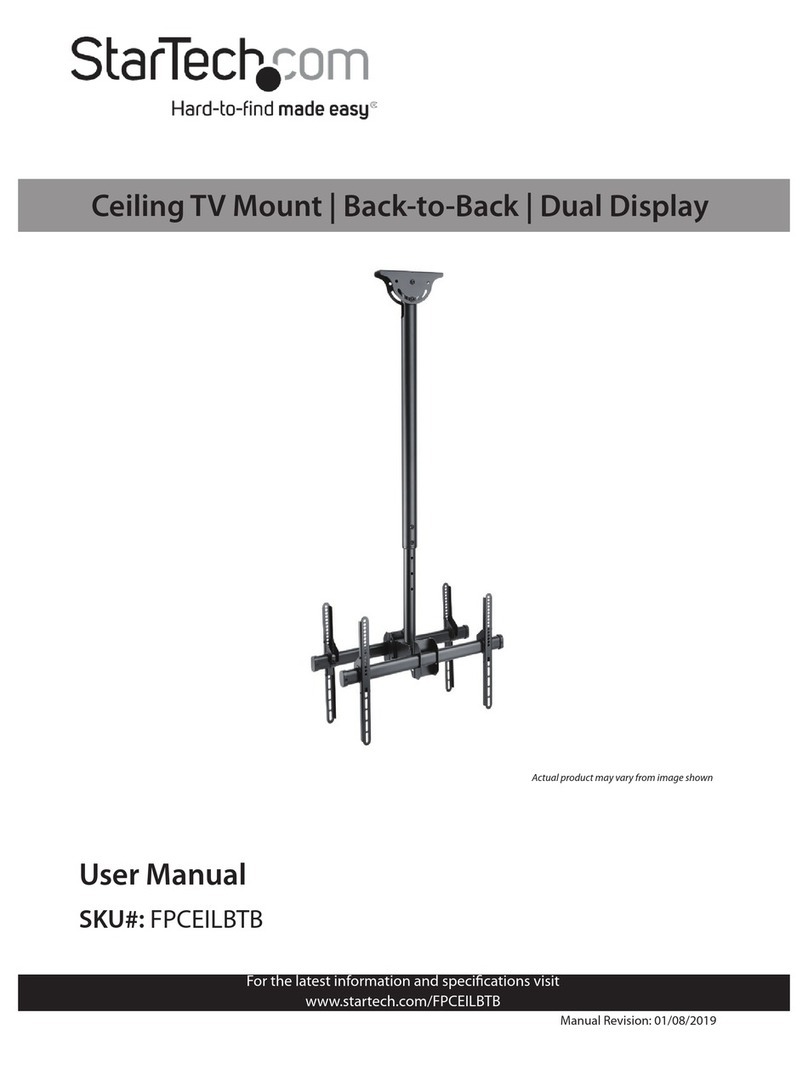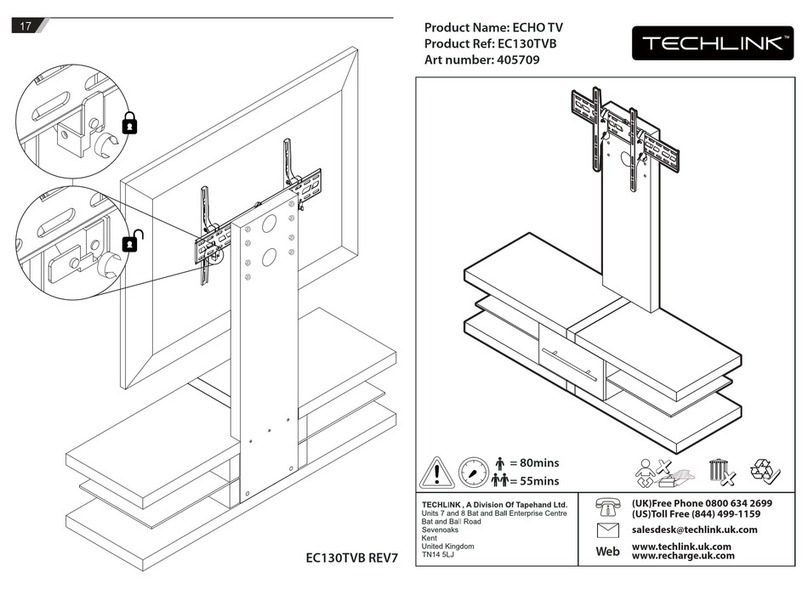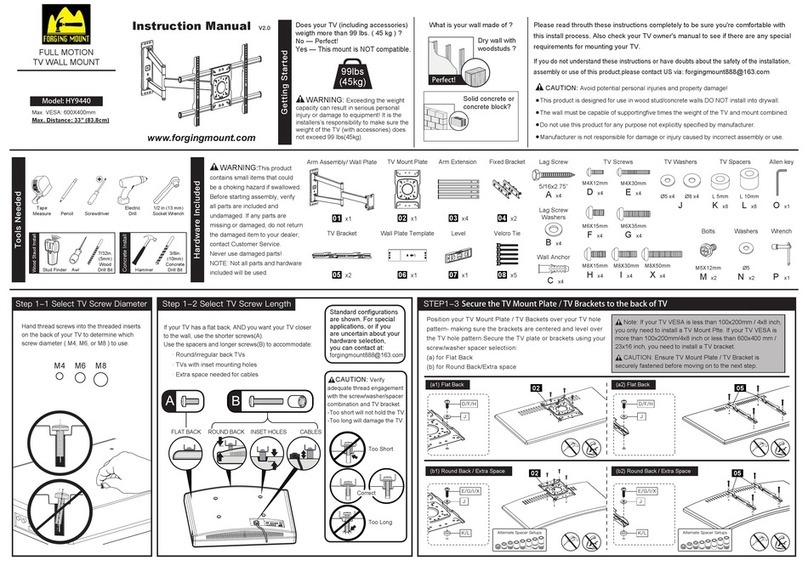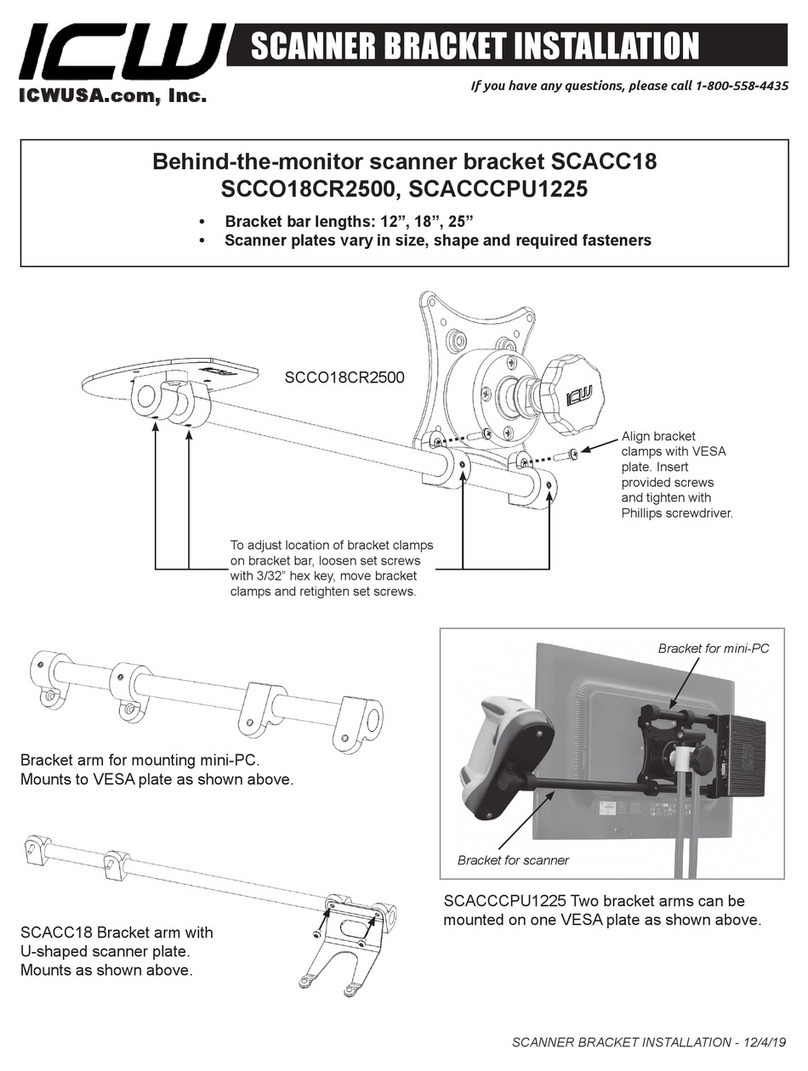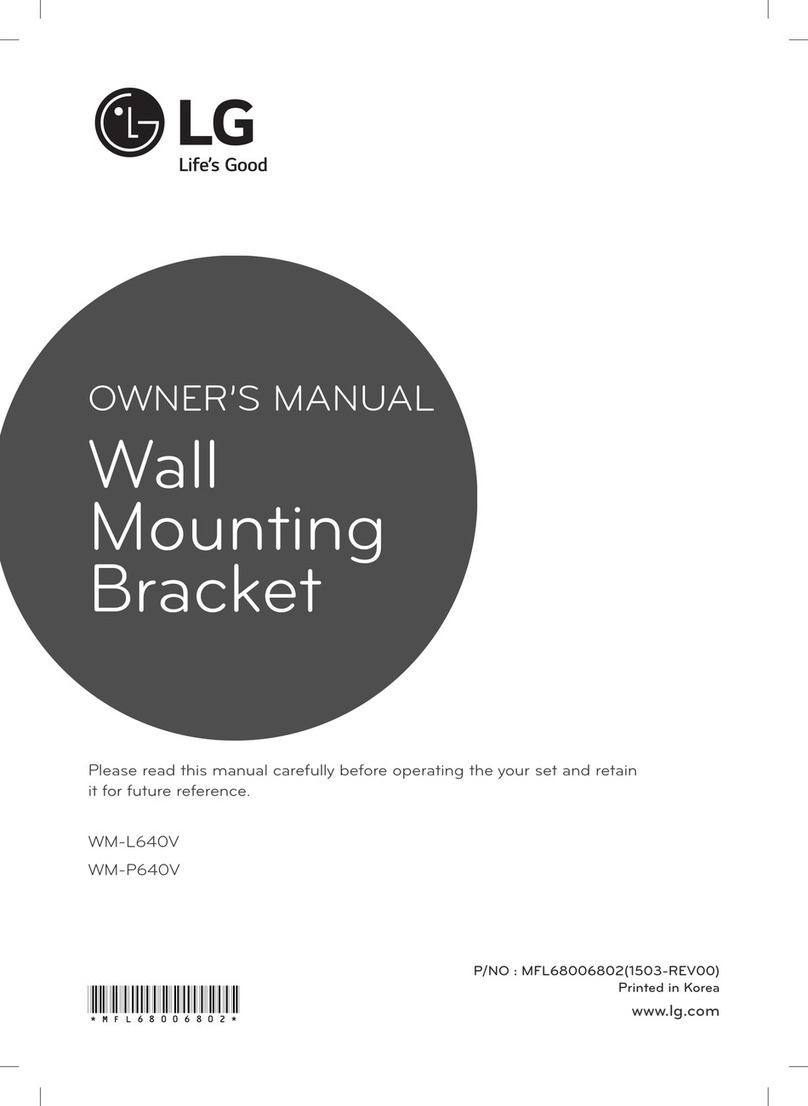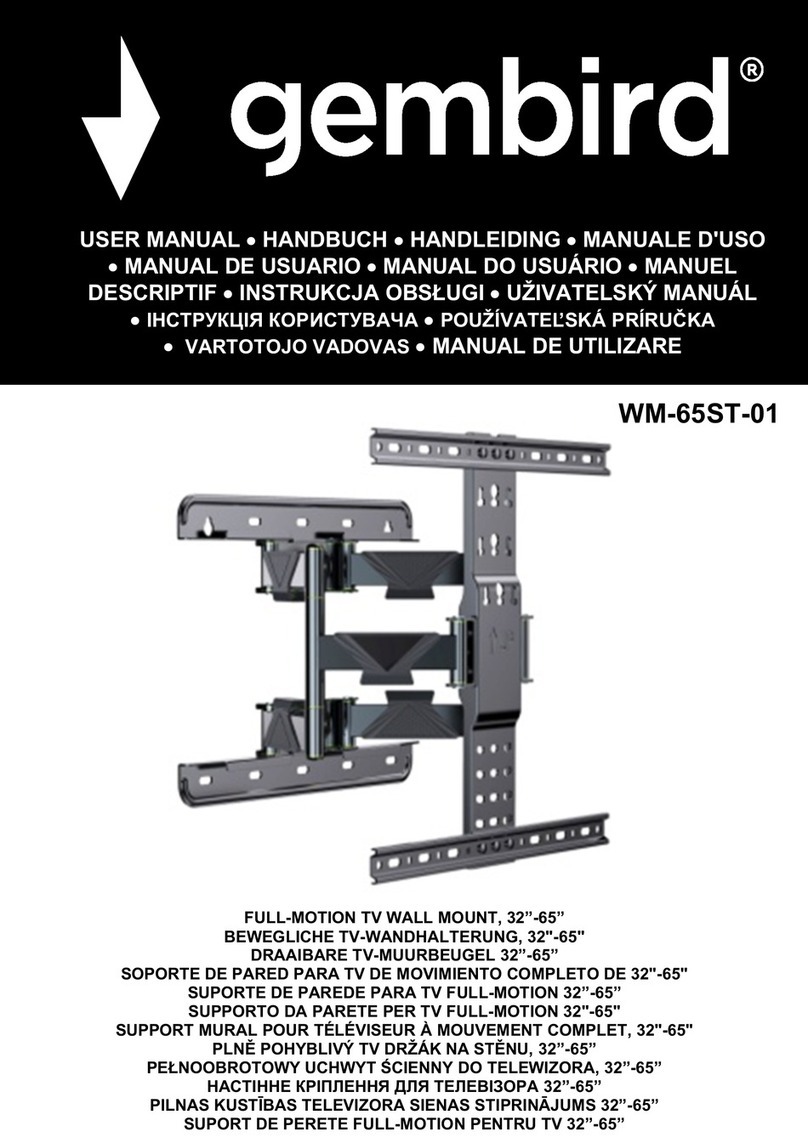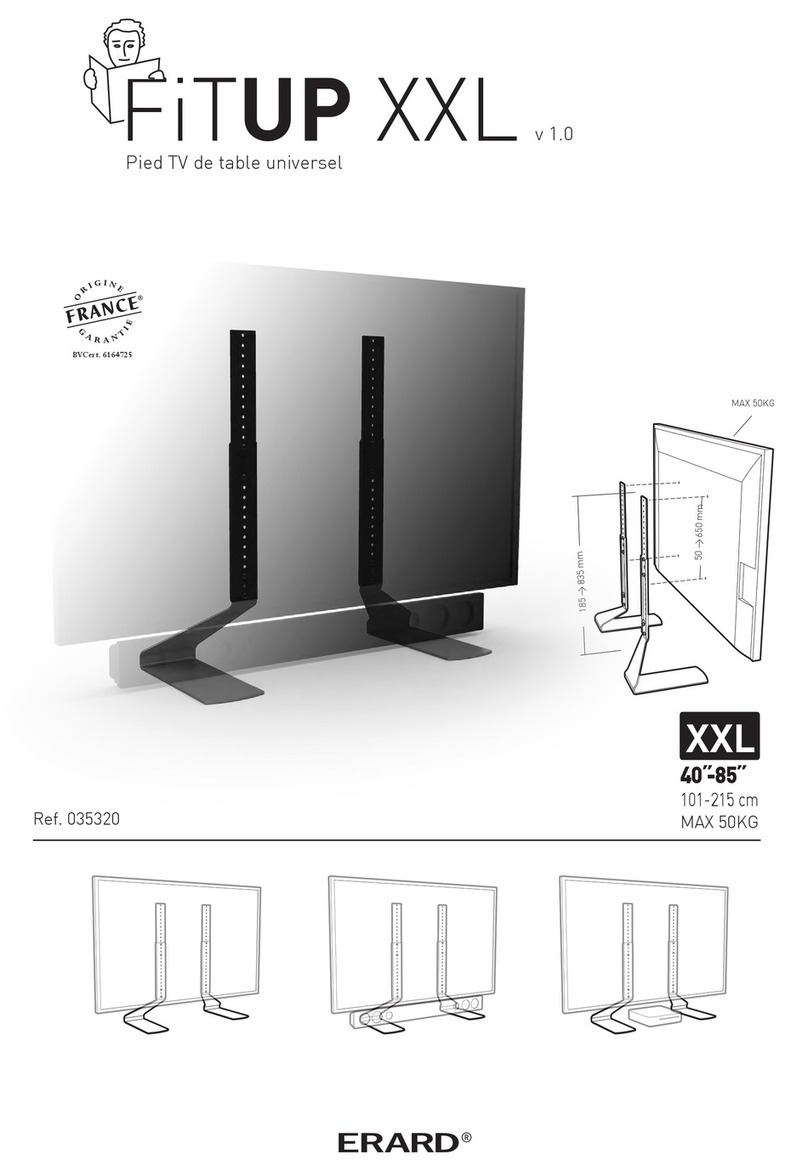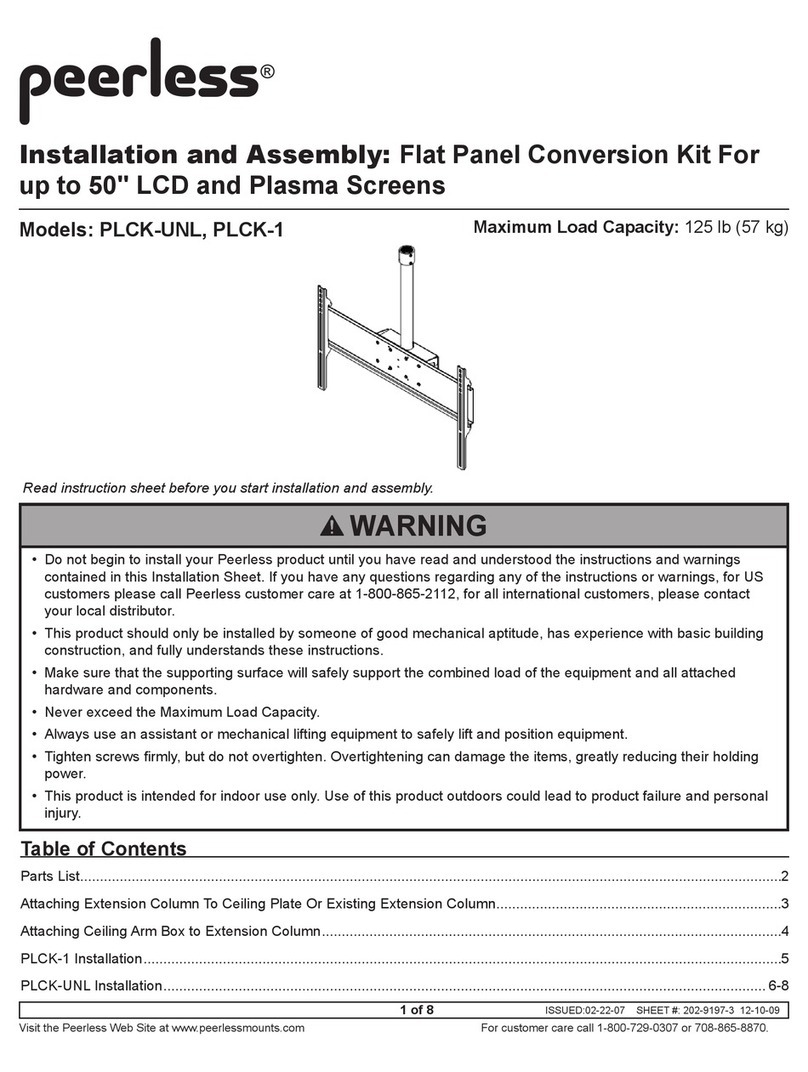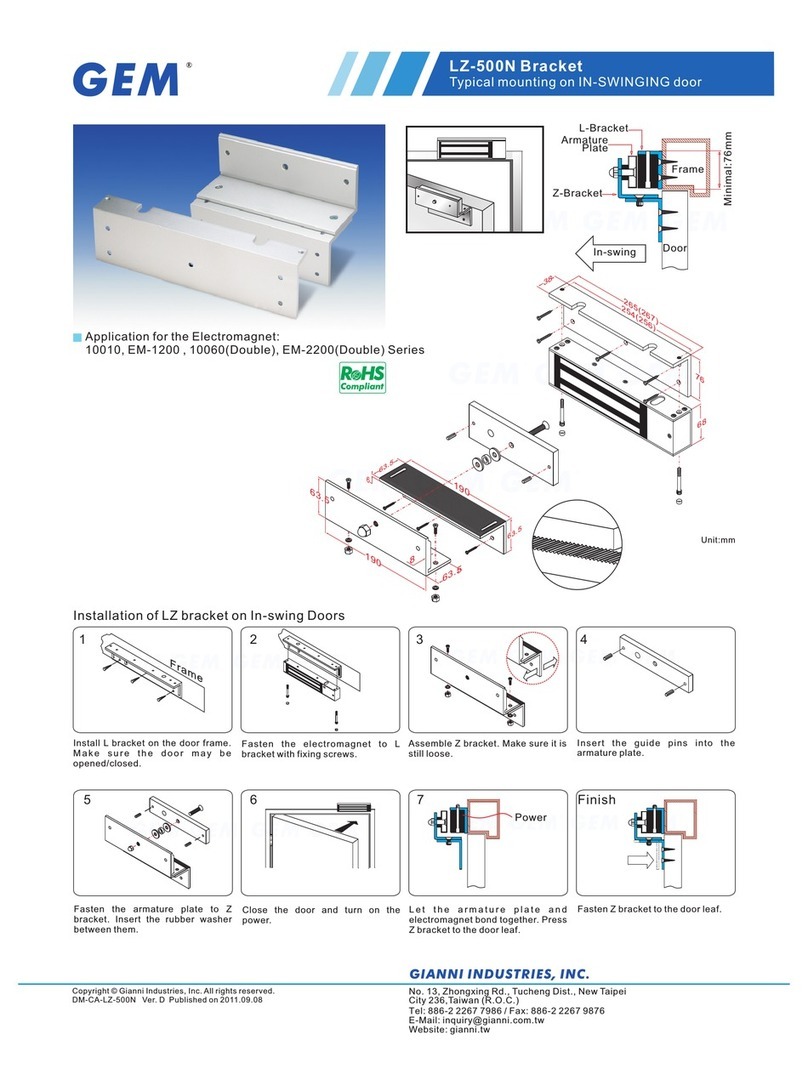Nexus 21 L-50s User manual

TV Lift System Model L-50s
Installation Instructions

2
Contact: Sup[email protected]
Toll Free: (866) 500-5438
Phone: (480) 951-6885
Fax: (480) 951-6879
Revised: 3/21/18
Below is a parts list describing all of the items included with the Model L-50s Lift System. You may also wish to
refer to the dimensional diagram shown on “Supplemental Page A” (at the end of this document).
Before beginning assembly and installation, please make sure that you have all items included on the list. If any
parts are missing or damaged, please contact Nexus 21. Our contact information is shown at the top of this
page.
Parts List
Screen Support
Column Clamp Extension
Screen Back Plate
Lift Column
Top Support Brackets
Column Clamp Base
Base Mount
Top Plate
Vertical Mounting Bars

3
Parts List, continued
Cables
•Motor Cable 2.5m (1) –Black cable with white, six-pin plugs. Use this cable to connect the Lift Column to the Control Box.
•Power Cable –Connects Control Box to power outlet. Three feet long.
•RF Cable (only present if you ordered the RF version of the Lift System) –Use to connect the RF Receiver to the Control
Box. Ends have RJ-45 connectors. One-foot long.
•Interface Cable –Six inch long black cable with one white six pin plug, one female mini jack port, and one female white six
pin port. Used for Swivel Cutoff Feature.
Hardware
1. Twelve (12) -- 6 x 12mm BHMS (Button Head Machine Screw)
2. Four (4) -- 6 x 16 BHMS (Button Head Machine Screw)
3. Four (4) -- 3/8” – 16 x ½” BHMS (Button Head Machine Screw)
4. Four (4) –6 x 12mm FHMS (Flat Head Machine Screw)
5. Four (4) –6 x 16mm FHMS (Flat Head Machine Screw)
6. Four (4) -- #8 x ¾” FHWS (Flat Head Wood Screw)
7. Two (2) -- #10 x 1-¾” FHWS (Flat Head Wood Screw)
8. Eighteen (18) -- #10 x ¾” THWS (Truss Head Wood Screw)
9. One (1) –Small Hex Key (4mm)
10. One (1) –Large Hex Key (7/32”)
11. Four (4) –Universal Lid Catches
12. One (1) –Large Assorted TV Hardware Pack
13. Two (2) –Threaded Tapered Pins
14. Four (4) –Wire Clips
15. Four (4) –Snakeskin Ties
16. Four (4) –Plastic Wire Ties
Additional Hardware included in “Swivel Pak”
17. Four (4) –6mm x 10mm Button Head Machine Screw
18.Four (4) –6mm x 16mm Button Head Machine Screw
19. One (1) –1.25” Flat Head Wood Screw
Wire Management
The Lift System has no exposed gears or moving parts that can damage your
wires, so wire management is simple. We have included a four-foot long
“SNAKESKIN” sleeve, which is a state-of-the-art wire bundling and protection
system (the sleeve can be cut shorter if you wish). The System also includes 4
Velcro end ties and 4 plastic ties. Use the Velcro ties at the ends of the
SNAKESKIN, to close the ends of the sleeve and to keep the wires together inside
it. Use the plastic ties to fasten the cable bundle in a fixed position, so it moves
up and down with the lift.
Control Box
Swivel Mechanism
Assorted TV Mounting Screws

4
SAFETY INFORMATION
SEVERE PERSONAL INJURY AND PROPERTY DAMAGE CAN RESULT FROM IMPROPER INSTALLATION OR
ASSEMBLY. READ THE FOLLOWING WARNINGS BEFORE BEGINNING:
WARNINGS:
1. Do not use this product for any application other than those specified by Nexus 21.
2. Do not exceed the weight capacity. This can result in serious personal injury or damage to the equipment. It is the installer’s responsibility
to ensure that the total combined weight of all attached components does not exceed that of the maximum figure stated.
3. Follow all technical specifications and instructions during the installation.
4. Only use attachments/accessories specified by the manufacturer.
5. Close supervision is necessary when this system is being used by, or near, children, or disabled persons.
6. It is the responsibility of the installer to warn all potential users of the dangers of interfering with the mechanism during operation.
7. Read all technical instructions fully before installation and use. It is the installer’s responsibility to ensure that all documentation is passed
on the users and read fully before operation.
8. Failure to provide adequate structural strengthening, prior to installation can result in serious personal injury or damage to the equipment.
It is the installer’s responsibility to ensure the structure to which the Lift System is affixed can support four times the weight of the system.
9. Risk of electric shock. Do not attempt to open the Control Box.
10. To reduce risk of fire or electric shock, do not expose parts to rain or other liquids.
11. Protect the power cord from being walked on or pinched.
12. Keep all documentation.
13. Heed all warnings.
14. Clean only with a dry cloth.
15. Refer all service questions to Nexus 21 if the system does not operate normally.
Nexus 21 disclaims any liability for modifications, improper installations, or installations over the specified weight range. Nexus 21 will not be liable for any damages
arising out of the use of, or inability to use, Nexus 21 products. Nexus 21 bears no responsibility for incidental or consequential damages. This includes, but is not
limited to, any labor charges for the servicing of Nexus 21 products performed by anyone other than Nexus 21.
Nexus 21 intends to make this and all documentation as accurate as possible. However, Nexus 21 makes no claim that the information contained herein covers all details,
conditions or variations, nor does it provide for every possible contingency in connection with the installation or use of this product. The information contained in this
document is subject to change without prior notice or obligation of any kind. Nexus 21 makes no representation of warranty, expressed or implied, regarding the
information contained herein. Nexus 21 assumes no responsibility for accuracy, completeness or sufficiency of the information contained in this document.
CABINET LID HAZARD
TV HAZARD
CAUTION: Avoid contact with the TV and Lift System during
operation. Use with caution.
CAUTION: The cabinet lid must be installed as described in the
instructions, using the Steel Threaded Tapered Pins. Installing
the cabinet lid in any other fashion will create hazardous pinch
points that can cause serious personal injury.

5
Types of Controls for Nexus 21 Lift Systems
All Nexus 21 Lift Systems come standard with a wireless remote control and receiver. We offer a choice of two different types of
remotes: IR and RF (both of which are explained in detail below). Our standard control type is RF, so unless you specifically requested
the IR version when you made your purchase, you probably received the RF controls with this Lift System. The method of installation
for each type of remote control is slightly different, so you should now identify which type of remote you have by reading below, and
then follow the instructions for that type of remote.
NOTE: If you will be using the Lift with a home control system (like the ones made by companies such as Crestron or Control 4) the
most common form of control is to WIRE IT DIRECTLY to the relays of your home control system. This direct-wire method is called
Integration by Contact Closure, and is accomplished by using the Contact Closure Hardware that is supplied with the IR Control Kit to
connect the Lift to your home control system.
Before You Begin the Installation: Identify Your Control Type
IR (Infrared) –This control option allows you to utilize a 3rd party universal style remote control to raise and lower the TV Lift.
Your universal remote will “learn” the IR codes from the provided IR Handset, which will enable you to control the lift. The universal
remote will then communicate with the “eye” located on the IR Receiver via your 3rd party emitter (or flasher). Instructions for
setting the TV Lift’s travel limit are on Page 30.
NOTE: If you are NOT planning on using a 3rd party Universal Remote, switch to the RF setup. (There is no charge for swapping)
These are the parts included with IR controls:
Contact Closure Hardware IR Receiver IR Handset Height Limit Insert
RF (Radio Frequency) - This system utilizes a wireless remote control handset that sends a radio signal to the RF Receiver. The
radio signal can go through cabinet walls and does not require line-of-sight. Instructions for setting the Lift System travel limit are on
Page 30.
TIP: Planning to integrate the TV Lift with your UNIVERSAL REMOTE CONTROL? The RF version of the Nexus 21 controls won’t do it. Switch to IR.
These are the parts included with RF controls:
Backup Switch RF Receiver RF Handset Height Limit Insert
Integration by Contact Closure –To direct-wire the TV Lift controls to a home control system (Crestron, Control 4, AMX, etc.)
you will use the Contact Closure Hardware. You won’t use any Nexus 21 receiver or handset for this type of control because you will
use the handset or control pad that comes with your home control system. Instructions for setting up the System using Contact
Closure are on “Page 31”.

6
Assembly and Mounting –Things to Think About First
SAFETY NOTICE:
- For proper support, the Lift System MUST NOT be attached to any material that is less than ¾” thick. This applies
to BOTH the back and bottom mounting points.
- The Lift Column is ONLY designed and rated for VERTICAL, NON-INVERTED USE. DO NOT MOUNT THIS LIFT
SYSTEM UPSIDE DOWN or SIDEWAYS (HORIZONTALLY)!
TIP: Inverted (drop-down) lift systems are available from Nexus 21. Contact Customer Service at (866) 500-5438.
Space requirements for the L-50s Lift System are as follows:
Depth = TV Depth + 6.625”
Height = TV Height + 1.5” or 30.25”, whichever is greater
Width = TV Width + 2” or 34”, whichever is greater
IMPORTANT NOTE: The Lift System must be mounted as high up as possible inside the cabinet, so that when
the Lift is in the fully “DOWN” position (fully retracted), the top of the TV will be just underneath the lid of the
cabinet. A 1/8” gap between the lid and the Top Plate is ideal.
Lift System height and mounting position:
The Top Support Brackets allow you to adjust the installation height of the Lift in ¼” increments if necessary. When fully
assembled in the standard configuration, the HEIGHT of the Lift will be a minimum of 30.25” up to a maximum of 42.25”
with the Top Support Brackets in the highest position. Reference the dimensional drawing for more information.
About the Cabinet Lid (Cabinet Top)
SAFETY NOTICE:
WARNING! YOU MUST NOT DIRECTLY SCREW THE CABINET LID (TOP) TO THE LIFT SYSTEM!! THIS CREATES
HAZARDOUS “PINCH POINTS” AND MAY AFFECT THE OPERATION OF THE LIFT OR CAUSE DAMAGE TO THE
CABINET TOP. For floating lids, DO NOT USE SCREWS to attach the lid to the Lift System. Instead, use the
“Threaded Taper Pins”. This will keep the lid firmly in place, but will also allow it to separate from the lift system if
anything (like a finger) gets in the way when the TV lowers.
Which Lid Style Will You Use? (There are 2 Different Styles) –Not Hinged Lid Compatible
Floating Lid (Floating Top) –The whole top of the cabinet sits on top of the Lift System and raises/lowers with the TV.
This is the standard Installation method, using the Top Plate and Threaded Tapered Pins.
Cut-Out Floating Lid (Top) –You will “cut out” part of your cabinet top, customizing it to the size of your TV. That cut-out
lid then sits on top of the Lift System and raises/lowers with the TV. This method uses the Top Plate and Threaded Taper
Pins, but you must set up a “catch” for the cut-out lid so that when the TV lowers, the lid stops level with the rest of your
cabinet top (like a manhole cover).

7
Table of Contents
1. Assembling and Installing the Actuation System
2. Connecting the Lift
3. Assembling and Installing TV Mounting System
4. Important Information About the Floating Lid
5. Installing the Tapered Pins in the Floating Lid
6. Installing the Lid Catch
7. Setting a Height Limit
8. L-50s Dimensional Drawing
9. Supplemental Page C: Connect the Lift to Home Control System

8
Assembling and Installing the Actuation System
For these steps you will need the following parts:
•Lift Column
•Base Mount
•Column Clamp Extension
•Column Clamp Base
•(4) 6 x16 FHMS
•(2) #10 x ¾” THWS
Step 1: Attach the Lift Column to the Base
Mount using the (4) 6 x 16 FHMS. Ensure
the pigtail for the Lift Column is facing
towards the front of the enclosure.
Step 2: Center the Lift Column and Base
Mount inside your enclosure.

9
Step 5: Slide the Column Clamp Base behind the Lift Column and line the holes up with the holes on the
Column Clamp Extension.
Step 4: Slide the Column Clamp Extension around
the front of the Lift Column and place it right below
the slots located on the left and right side of the Lift
Column.
Step 3: Fasten the Base Mount to both the bottom and
rear panel of the enclosure using (8) #10 x ¾” THWS
Step 6: Fasten the two brackets against the rear panel
of the enclosure using (2) #10 x ¾” THWS

10
Connecting the Lift
For these steps you will need the following parts:
•Control Box
•Power Cord
•Wired Backup Switch
•Interface Cable
•Swivel Mechanism
•CSI Control Kit (If IR was ordered)
•RF Control Kit (If RF was ordered)
•(2) #10 x 1-¾” FHWS
•(4) #8 x ¾” FHWS
Step 7: Connect the 2.5m Motor Cable to the pigtail
at the top of the Lift Column.
Step 8: Connect the other end of the 2.5m Motor Cable to the
Interface Cable, connect the Interface Cable to Port 1 on the
Control Box, then connect the headphone jack from the Swivel
to the headphone port on the Interface Cable.
Note: The Swivel will not need to be attached at this point.
Step 9: Connect the Wired Backup Switch to Port A1 on the Control Box, if
you are using RF Controls. Connect the IR Receiver to Port A1 on the Control
Box, if you are using IR Controls.

11
Step 11: Connect the RF Receiver to Port A2 on the Control Box, if you are
using RF Controls. Leave Port A2 blank if you are using IR Controls.
Step 10: Connect the Power Cord to Port AC on the Control Box then
connect the cord to a power receptacle.
Step 12:Using the Wired Backup Switch or IR Receiver, press the DOWN button once, then press and hold
it again for 5 seconds to “Initialize” the Lift System.
Note: You will hear or see the lift jog or move up and down very slightly. This is the “reset/calibration”
feature of the lift system and must be done to ensure proper function.
Step 13: Extend the Lift System by pressing the UP button on the Wired
Backup Switch.
UP
DOWN

12
Assembling and Installing TV Mounting System
For these steps you will need the following parts:
•Screen Support
•Swivel Mechanism
•(2) Top Support Brackets
•Top Plate
•Screen Back Plate
•(2) Vertical Mounting Bars
•Screen Locks
•(4) 3/8”-16 x ¾” BHMS
•(4) 6 x 16mm BHMS
•(8) 6 x 12mm BHMS
•(4) 6 x 10mm BHMS (Located in Swivel Pack)
•(4) 6 x 12mm FHMS
Step 15: Attach the Screen Support to the top of Swivel Mechanism using
(4) 6 x 10mm BHMS located in the Swivel Hardware Pack. Use the four
mounting locations that are marked with dots on the Screen Support.
Step 14a: Split the Swivel into two pieces by pulling on the Upper Section while holding the Lower Section,
then attach the Lower Section of the Swivel to the top of the Lift Column using (4) 6 x 16 BHMS Screws.
Step 14b:Place the Upper Section of the Swivel back
onto the Lower Section, then fasten the two together
by placing an Allen Key into the “Unthreaded” Holes on
the top of the Swivel.
Note: Tighten the Swivel in a “star” pattern to avoid
attaching the Swivel crooked. Ensure the blue switch is
facing towards the front of the cabinet.

13
Step 18: Attach the Top Plate to the top
of the Top Support Brackets using the
(4) 6 x 12 FHMS
Step 19: Attach the Screen Back Plate to the Screen Support using the (4) 3/8 –16 x3/4” BHMS.
Tip:
You can generally measure from the Top of the TV to the center of the VESA, this is the distance the
center of the Screen Back Plate will need to be from the Top Support Brackets.
Step 16: Measure the Interior Height of the Cabinet and subtract 29.625” from it. This will be the distance
you will need to attach the Top Support Brackets above the Screen Support.
Step 17: Attach both Top Support Brackets to the sides of the
Screen Support using (8) 6 x 12mm BHMS, (4) per side.

14
The following Diagrams show information on how to attach the Vertical Mounting Bars to the TV in 2 Scenarios.
All hardware mentioned in these diagrams is inside the Large Assorted TV Hardware Pack, however other hardware may be
necessary based on TV model. Refer to the TV Manual for screw sizing information.
Step 20:Attach the Vertical Mounting Bars to the back of the TV using the provided Large Assorted TV
Hardware.
Irregular/Obstructed Back
Flat/Unobstructed Back
A
B
Diagram “A” installation procedure:
1) Place the flat screen TV face down on a
protected surface.
2) Position the Vertical Mounting Bars
equidistant from the bottom and top of
the TV, with the slots facing toward
the top of the TV.
3) Using the four (4) Square Multi-Mount
washers and the TV mounting screws selected
from the bag, attach and tighten the hardware.
DO NOT OVERTIGTHEN HARDWARE. DAMAGE TO TV MAY RESULT.
Diagram “B”installation procedure:
1) Place the flat screen TV face down on a protected surface.
2) Position the Vertical Mounting Bars equidistant from
the bottom and top of the TV, with the slots facing
toward the top of the TV.
3) Using the four (4) spacers needed,
(4) Square Multi-Mount washers and the
TV mounting screws selected from the bag,
attach and tighten the hardware.
The hardware will be used in this order
(as shown in the diagram above):
TV, Spacers, Vertical Mounting Bars, Square Multi-Mount Washers, TV Mounting Screws.
DO NOT OVERTIGTHEN HARDWARE. DAMAGE TO TV MAY RESULT.

15
Step 21:Mount the TV to the Lift System by hanging the Vertical
Mounting Bars on the Screen Back Plate.
Step 22:Insert the Screen Locks into the lower section of hooks
the rest right below the Screen Back Plate and fasten them using
a Phillips Screw Driver.

16
Important Information About the Floating Lid
What Are the Tapered Pins, and Why Use Them?
The two 1½” x ¼” Steel Threaded Tapered Pins are used IN PLACE OF SCREWS to hold your cabinet top (lid) in place on the Lift
System Top Plate (Part #8). The Tapered Pins will keep your lid firmly in place, but will also allow it to separate from the lift system
if anything (like a finger) gets in the way when the TV lowers. See Safety Notice above. Please do NOT use screws with your cabinet
lid.
Before You Install the Tapered Pins, Here is a Reminder of the Two Types of Floating Lids (Floating Tops):
Floating Lid (Floating Top) –The whole top of the cabinet sits on top of the Lift System and raises/lowers with the TV.
Cut-Out Floating Lid (Top) –This option assumes that you have “cut out” part of your cabinet top, customizing it to the size of your
TV. That cut-out lid then sits on the Top Plate of the Lift System, held in place by the Taper Pins, and raises/lowers with the TV. You
must set up a “catch” for the Cut-Out Lid so that when the TV lowers, the Lid stops level with the rest of your cabinet top (like a
manhole cover), and the Lift System continues down a little further into the cabinet (no more than ¼” to ½”). In this way, when the
Lift System is fully retracted, the Cut-Out Lid will always be level, and the Top Plate of the Lift System will always be positioned just
below the Lid. Since the Lid and the Top Plate are slightly separated from one another, but still very close, the Taper Pins (which are
1½” long) will still be hanging down through the holes in the Top Plate so when the Lift System moves, everything is properly aligned
and the Lid rides smoothly up and down.

17
Installing the Tapered Pins in the Floating Lid
For these steps you will need the following parts:
•Threaded Tapered Pins
•7/32” Drill Bit
•Phillips Screw Driver
•Cabinet Lid
•(Optional) Wood Glue
•(Granite Only) Epoxy
UP
DOWN
Step 23:Fully retract the lift by pressing the DOWN button on the Remote
or Wired Backup Switch.
Note: If you need to stop the lift at any point, tap the UP button to stop it.
Step 24: Place the Cabinet Lid on top of the Top Plate and position it so it is centered within the enclosure
cutout.
Step 25: Run the lift up by pressing the UP button on the Remote or Wired Backup Switch. Ensure the lid
stays in position and is not bumped, shifted, or moved out of place.

18
Step 26: Using a pencil, sharpie, or felt-tipped
pen, mark the position for the Tapered Pins
from the underside of the Top Plate.
Step 27: Remove the Lid, and drill two holes ½” deep in the two
marked positions using a 7/32” drill bit.
Step 28: Thread the provided Tapered Pins into the holes using a phillips
screwdriver.
Note: Glue can be used to further secure the pins into position. If using
granite, you can bore the hole slightly larger than the pins and Epoxy it
into place.

19
Step 29: Place the Lid on top of the Lift System, lining
the Tapered Pins up with the holes used to locate the
pins in step 22.
Step 30:Run the lift down then up to test and ensure the position of the lid is correct. If the position of
the pins are off, loosen the nuts for Pin Nests located on the underside of the lid and position the lid so
that it is centered within the enclosure cutout.
Note: The Pin Nests are adjustable ¼” in every direction.
Pin Nest
Pin Nest

20
Installing the Lid Catch
In order for the Lid to always rest flush with the surrounding cabinet or countertop, you must install a Lid
Catch. A Lid Catch functions similar to a “manhole cover” in the it catches lid allowing the Lift System to
breakaway and allow gravity to ensure the lid sits flush. A few examples of this are depicted below:
Using the provided Universal Lid Catches:
Alternative using a wooden “Lip” or “Catch” built into the cabinet:
This manual suits for next models
1
Table of contents
Other Nexus 21 TV Mount manuals

Nexus 21
Nexus 21 DL-50b User manual

Nexus 21
Nexus 21 L-65 HTG User manual

Nexus 21
Nexus 21 XL-75s User manual

Nexus 21
Nexus 21 L-45ens User manual
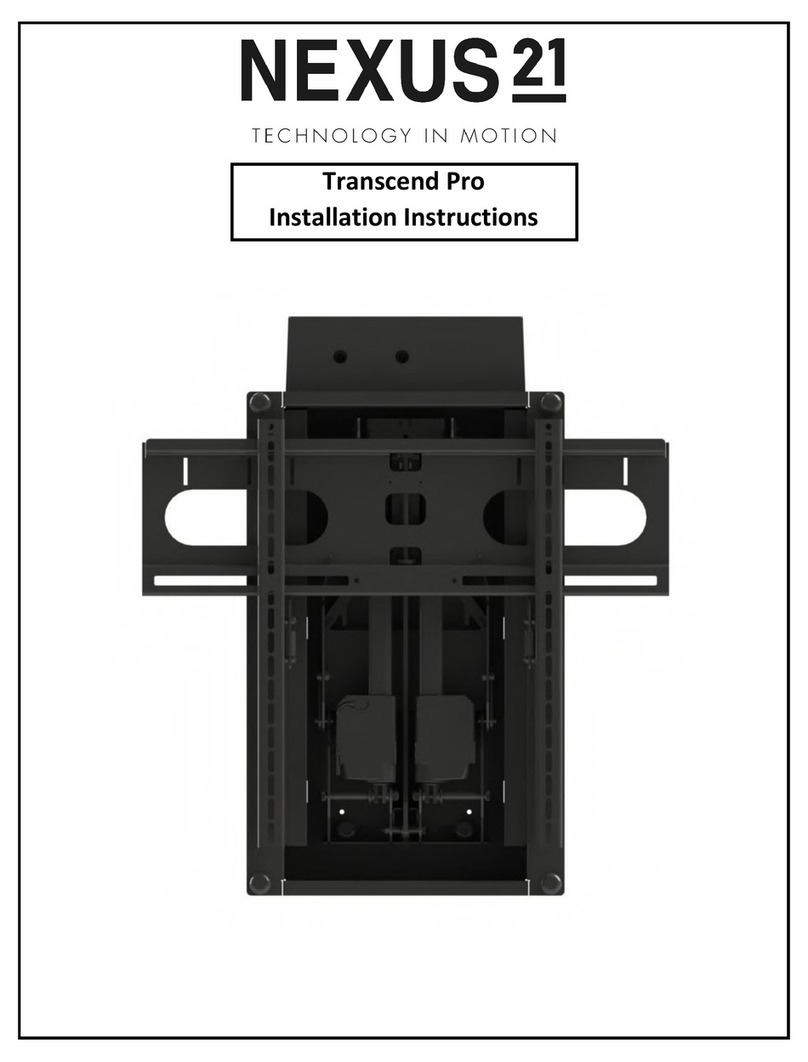
Nexus 21
Nexus 21 Transcend Pro User manual
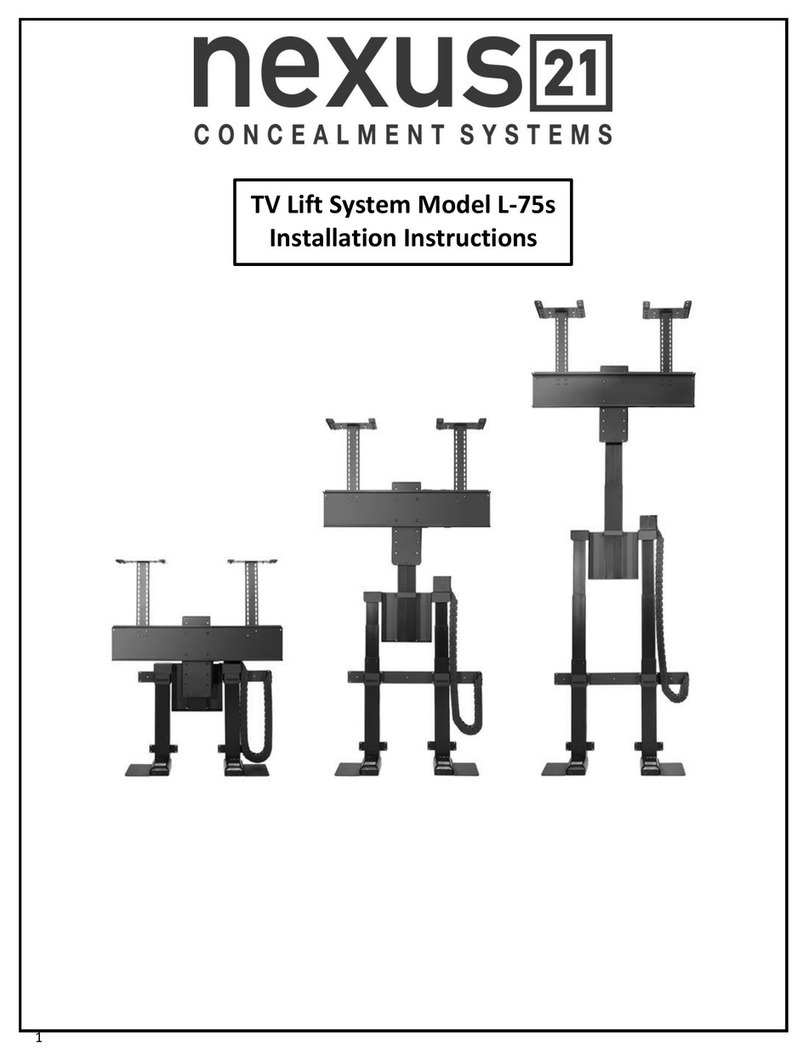
Nexus 21
Nexus 21 L-75s Installation guide

Nexus 21
Nexus 21 L-45en User manual

Nexus 21
Nexus 21 ML-65 User manual

Nexus 21
Nexus 21 DL-50 User manual

Nexus 21
Nexus 21 L-85s User manual
